When you're thinking about investing in a product or service, what's the first thing you do?

Usually, it’s one or both of the following: You'll likely ask your friends whether they've tried the product or service, and if they have, whether they would recommend it. You'll also probably do some online research to see what others are saying about said product or service. Nowadays, 90% of consumers used the internet to find a local business in the last year, and 82% of consumers read online reviews. This shows that the majority of people are looking to peers to make a purchasing decision.Most customers know that a little online research could spare them from a bad experience and poor investment of your budget.
What Is a Marketing Case Study?
A case study is the analysis of a particular instance (or "case") of something to demonstrate quantifiable results as a result of the application of something. In marketing, case studies are used as social proof — to provide buyers with the context to determine whether they're making a good choice.
A marketing case study aims to persuade that a process, product, or service can solve a problem. Why? Because it has done so in the past. By including the quantitative and qualitative outcomes of the study, it appeals to logic while painting a picture of what success looks like for the buyer. Both of which can be powerful motivators and objection removers.
Why Use Case Studies?
In essence, case studies are an invaluable asset when it comes to establishing proof that what you're offering is valuable and of good quality.
According to HubSpot's State of Marketing Report 2020, 13% of marketers name case studies as one of the primary forms of media used within their content strategy. This makes them the fifth most popular type of content, outshined only by visual content, blogs, and ebooks.
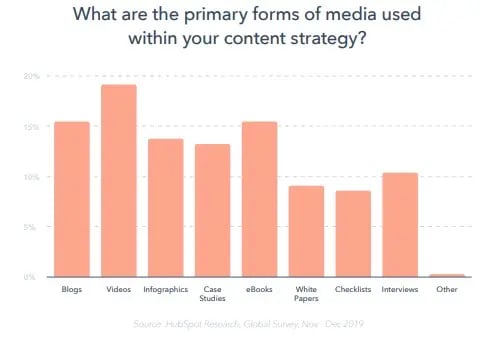
Okay, so you know case studies work. The question is, how do they work? And how can you squeeze the most value out of them?
When to Use a Case Study
Here are the ways you can market your case studies to get the most out of them.
As a Marketing or Sales Asset
1. Use a case study template to create PDFs for email or downloads.
Do not underestimate the value of providing social proof at just the right time in order to add value and earn their business. Case studies are extremely effective in the consideration stage of the buyer's journey when they are actively comparing solutions and providers to solve a problem they're experiencing.
For this reason, case studies in an independent PDF format can be helpful in both marketing and sales. Marketers can use these PDFs as downloads in web content or email campaigns. Sales reps can utilize these assets in demonstrations, in a follow-up, or to overcome objections.
The easiest way to create PDF case studies is by using a case study template. Doing so can decrease the amount of time you spend creating and designing your case study without sacrificing aesthetics. In addition, you can ensure that all your case studies follow a similar branded format.
We've created a great case study template (and kit!) that's already locked and loaded for you to use. All you have to do is input your own text and change the fonts and colors to fit your brand. You can download it here.
On Your Website
2. Have a dedicated case studies page.
You should have a webpage exclusively for housing your case studies. Whether you call this page "Case Studies, "Success Studies," or "Examples of Our Work," be sure it's easy for visitors to find.
Structure on that page is key: Initial challenges are clear for each case, as well as the goals, process, and results.
Get Inspired: Google’s Think With Google is an example of a really well structured case study page. The copy is engaging, as are the goals, approach, and results.
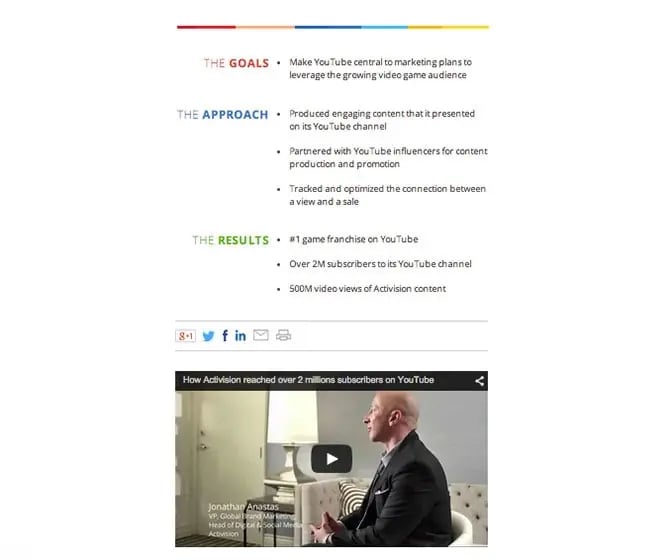
3. Put case studies on your home page.
Give website visitors every chance you can to stumble upon evidence of happy customers. Your home page is the perfect place to do this.
There are a number of ways you can include case studies on your homepage. Here are a few examples:
- Customer quotes/testimonials
- A call-to-action (CTA) to view specific case studies
- A slide-in CTA that links to a case study
- A CTA leading to your case studies page
Get Inspired: Theresumator.com incorporates testimonials onto their homepage to strengthen their value proposition.
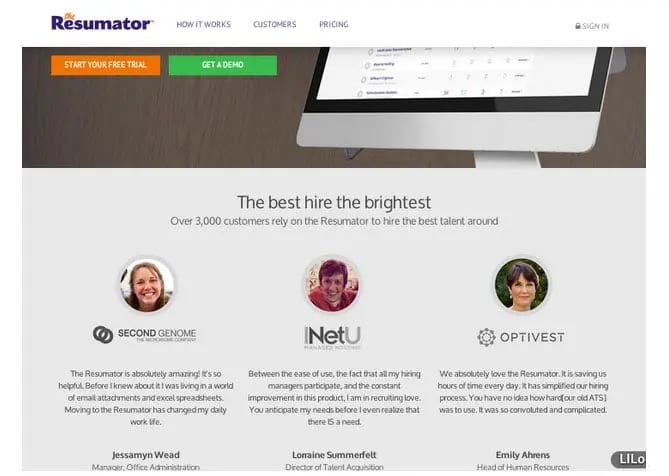
Bonus Tip: Get personal.
Marketing gurus across the world agree that personalised marketing is the future. You can make your case studies more powerful if you find ways to make them “match” the website visitors that are important to you.
People react to familiarity -- for instance, presenting someone from London with a case study from New York may not resonate as well as if you displayed a case study from the U.K. Or you could choose to tailor case studies by industry or company size to the visitor. At HubSpot, we call this "smart content."
Get Inspired: To help explain smart content, have a look at the example below. Here, we wanted to test whether including testimonials on landing pages influenced conversion rates in the U.K. The landing page on the left is the default landing page shown to visitors from non-U.K. IP addresses. For the landing page on the right, we used smart content to show testimonials to visitors coming from U.K. IP addresses.
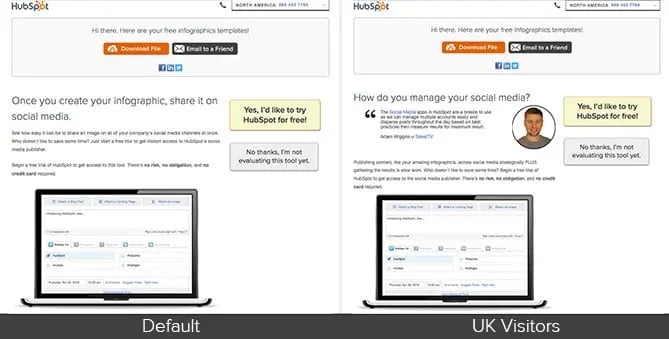
4. Implement slide-in CTAs.
Pop-ups have a reputation for being annoying, but there are ways to implement that that won't irk your website visitors. These CTAs don't have to be huge, glaring pop-ups -- instead, relevant but discreet slide-in CTAs can work really well.
For example, why not test out a slide-in CTA on one of your product pages, with a link to a case study that profiles a customer who's seen great results using that product?
Get Inspired: If you need some help on creating sliders for your website, check out this tutorial on creating slide-in CTAs.
5. Write blog posts about your case studies.
Once you publish a case study, the next logical step would be to write a blog post about it to expose your audience to it. The trick is to write about the case study in a way that identifies with your audience’s needs. So rather than titling your post “Company X: A Case Study," you might write about a specific hurdle, issue, or challenge the company overcame, and then use that company's case study to illustrate how the issues were addressed. It's important not to center the blog post around your company, product, or service -- instead, the customer’s challenges and how they were overcome should take centre stage.
For example, if we had a case study that showed how one customer generated twice as many leads as a result of our marketing automation tool, our blog post might be something along the lines of: "How to Double Lead Flow With Marketing Automation [Case Study]." The blog post would then comprise of a mix of stats, practical tips, as well as some illustrative examples from our case study.
Get Inspired: Check out this great example of a blog post from Moz, titled "How to Build Links to Your Blog – A Case Study."
6. Create videos from case studies.
Internet services are improving all the time, and as a result, people are consuming more and more video content. Prospects could be more likely to watch a video than they are to read a lengthy case study. If you have the budget, creating videos of your case studies is a really powerful way to communicate your value proposition.
Get Inspired: Check out one of our many video testimonials for some ideas on how to approach your own videos.
7. Use case studies on relevant landing pages.
Once you complete a case study, you'll have a bank of quotes and results you can pull from. Including quotes on product pages is especially interesting. If website visitors are reading your product pages, they are in a "consideration" mindset, meaning they are actively researching your products, perhaps with an intent to buy. Having customer quotes placed strategically on these pages is a great way to push them over the line and further down the funnel.
These quotes should be measured, results-based snippets, such as, “XX resulted in a 70% increase in blog subscribers in less an 6 months” rather than, “We are proud to be customers of XX, they really look after us."
Get Inspired: I really like the way HR Software company Workday incorporates video and testimonials into its solutions pages.

Off Your Website
8. Post about case studies on social media.
Case studies make for perfect social sharing material. Here are a few examples of how you can leverage them on social:
- Share a link to a case study and tag the customer in the post. The trick here is to post your case studies in a way that attracts the right people to click through, rather than just a generic message like, “New Case Study ->> LINK." Make sure your status communicates clearly the challenge that was overcome or the goal that was achieved. It's also wise to include the main stats associated with the case study; for example, "2x lead flow," "125% increase in X," and so on.
- Update your cover image on Twitter/Facebook showing a happy customer. Our social media cover photo templates should help you with this!
- Add your case study to your list of publications on LinkedIn.
- Share your case studies in relevant LinkedIn Groups.
- Target your new case studies to relevant people on Facebook using dark posts. (Learn about dark posts here.)
Get Inspired: MaRS Discovery District posts case studies on Twitter to push people towards a desired action.
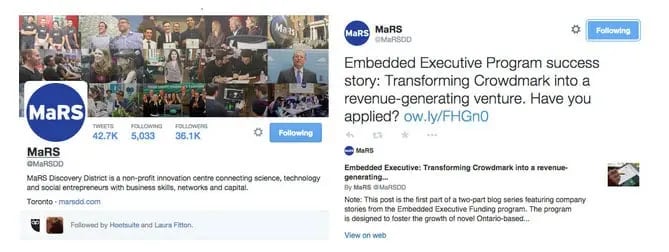
9. Use case studies in your email marketing.
Case studies are particularly suited to email marketing when you have an industry-segmentable list. For example, if you have a case study from a client in the insurance industry, emailing your case study to your base of insurance-related contacts can be a really relevant addition to a lead nurturing campaign.
Case studies can also be very effective when used in product-specific lead nurture workflows in reactivating opportunities that have gone cold. They can be useful for re-engaging leads that have gone quiet and who were looking at specific areas of your product that the case study relates to.
Get Inspired: It's important that your lead nurture workflow content includes the appropriate content for where prospects are in the sales cycle. If you need help on how to do this, check out our post on how to map lead nurturing content to each stage in sales cycle.
Pro tip: When sending emails, don't forget about the impact a good email signature can make. Create your own using our free Email Signature Generator.
10. Incorporate case studies into your newsletters.
This idea is as good for your client relations as it is for gaining the attention of your prospects. Customers and clients love feeling as though they're part of a community. It’s human nature. Prospects warm to companies that look after their customers; companies whose customers are happy and proud to be part of something. Also, whether we are willing to admit it or not, people love to show off!
Get Inspired: Newsletters become stale over time. Give your newsletters a new lease of life with our guide on how to create newsletters that don't suck.
11. Equip your sales team with case studies.
Tailored content has become increasingly important to sales reps as they look to provide value on the sales call. It's estimated that consumers go through 70-90% of the buyer's journey before contacting a vendor. This means that the consumer is more knowledgeable than ever before. Sales reps no longer need to spend an entire call talking about the features and benefits. Sales has become more complex, and reps now need to be armed with content that addresses each stage of the buyer’s process. Case studies can be really useful when it comes to showing prospects how successful other people within a similar industry has benefited from your product or service.
Get Inspired: Case studies are just one type of content that helps your sales team sell. They don't always work by themselves, though. Check out our list of content types that help sales close more deals.
12. Sneak a case study into your email signature.
Include a link to a recent case study in your email signature. This is particularly useful for salespeople. Here's what my email signature looks like:

Get Inspired: Did you know that there are lots more ways you can use your email signature to support your marketing? Here are 10 clever suggestions for how you can do this.
13. Use case studies in training.
Having customer case studies is an invaluable asset to have when onboarding new employees. It aids developing their buy-in, belief in, and understanding of your offering.
Get Inspired: Have you completed our Inbound Certification course yet? During our classes, we use case studies to show how inbound marketing is applied in real life.
In Lead-Gen Content
14. Include case studies in your lead gen efforts.
There are a number of offers you can create based off of your case studies, in the form of ebooks, templates, and more. For example you could put together an ebook titled “A step-by-step guide to reaching 10,000 blog subscribers in 3 months…just like XX did.” You could create a more in-depth version of the case study with access to detailed statistics as an offer. (And don’t forget, you can also use quotes and statistics from case studies on the landing page promoting the ebook, which adds credibility and could increase your conversion rates.) Or, you could create a template based on your customer's approach to success.
Get Inspired: If you think you need to be an awesome designer put together beautiful ebooks, think again. Create ebooks easily using these customisable ebook templates.
You can also use case studies to frame webinars that document how to be successful with X. Using case studies in webinars is great middle-of-the-funnel content and can really help move your leads further down the funnel towards becoming sales qualified leads.
Get Inspired: Webinars are really effective as part of a lead nurturing workflow. Make sure your next webinar is spot on by following these simple webinar tips.
15. Create a bank of evergreen presentations.
It’s important to build up a bank of evergreen content that employees across your organisation can use during presentations or demos. Case studies are perfect for this.
Put together a few slides on the highlights of the case study to stir people’s interest, and then make them available to your sales and customer-facing teams. It's helpful if the marketer who created the presentation is the one who presents it to anyone who might use them in the future. This ensures they can explain the presentation clearly and answer any questions that might arise.
Get Inspired: What to create presentations people want to use? Here's a list of tools to make your presentations great.
16. Create SlideShares based on case studies.
Following on from a few short slides, you could also put together a more detailed presentation of the case study and upload it to SlideShare. After all, not only is SlideShare SEO-friendly (because Google indexes each presentation), but there is a huge pre-existing audience on SlideShare of over 60 million users you can tap into. SlideShare presentations are also easy to embed and share, and allow you to capture leads directly from the slides via a lead capture form.
Get Inspired: Want to generate more leads with SlideShare, but not sure how to get started? Check out this blog post.
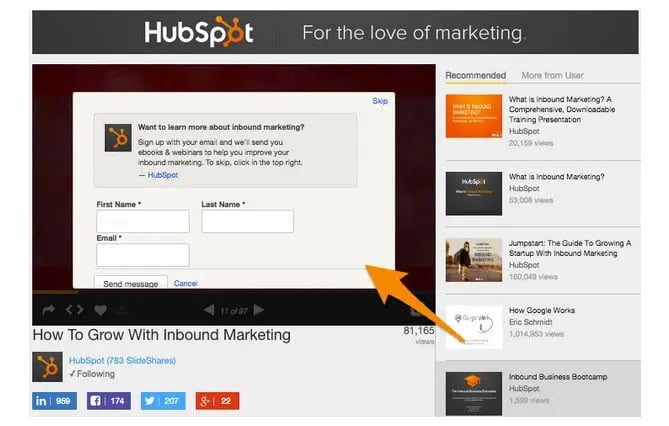
Now that you understand the value of a marketing case study and the different ways that they can be used in your content marketing (and even sales) strategy, your next step is to think about what would convince your target audience to do business with you.
Have you recently accomplished something big for a client? Do you have a process or product with demonstrable results? What do your potential clients hope that you'll do for them?
The answers to those questions will help you craft compelling content for your case study. Then, all that's left is putting it into your audience's hands in formats they want to consume.
Editor's note: This post was originally published in January 2015 and has been updated for comprehensiveness.

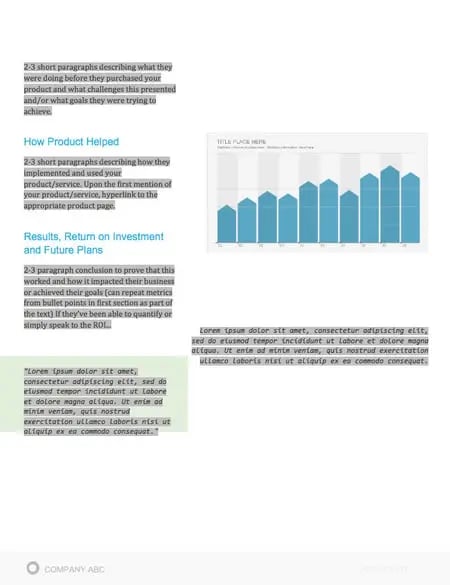



![7 Pieces of Content Your Audience Really Wants to See [New Data]](https://blog.hubspot.com/hubfs/most%20popular%20types%20of%20content.jpg)
![How to Write a Listicle [+ Examples and Ideas]](https://blog.hubspot.com/hubfs/listicle-1.jpg)

![What Is a White Paper? [FAQs]](https://blog.hubspot.com/hubfs/business%20whitepaper.jpg)



